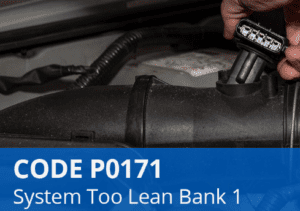Toyota P0171 And P0174 – Engine/Hybrid System

Causes and troubleshooting :
Toyota P0171 And P0174 :
The Diagnostic Trouble Codes (DTCs) P0171 and P0172 in a Toyota vehicle indicate issues with the air-fuel mixture in the engine. Specifically, these codes reflect conditions where the mixture is too lean (P0171) or too rich (P0172). Here’s a detailed overview of each code, their causes, symptoms, and possible troubleshooting steps:
DTC P0171 – System Too Lean (Bank 1)
Description:
- The P0171 code indicates that the air-fuel mixture is too lean on Bank 1, meaning there is too much air and not enough fuel in the combustion process.
Common Causes:
- Vacuum Leaks:
- A vacuum leak allows extra air to enter the engine, causing a lean condition. This can occur in vacuum hoses, intake manifold gaskets, or the throttle body.
- Mass Air Flow (MAF) Sensor Issues:
- A dirty or faulty MAF sensor can incorrectly measure the amount of air entering the engine, leading to an incorrect air-fuel mixture.
- Fuel Delivery Problems:
- Low fuel pressure, a clogged fuel filter, or faulty fuel injectors can result in insufficient fuel delivery to the engine, causing a lean condition.
- Oxygen Sensor Malfunction:
- A faulty oxygen (O2) sensor can send incorrect data to the Engine Control Module (ECM), leading to improper air-fuel adjustments.
- Exhaust Leaks:
- An exhaust leak before the O2 sensor can cause the sensor to read more oxygen than is actually present, leading to a lean condition.
Symptoms:
- Check Engine Light (CEL) Illuminated: The CEL will light up when the P0171 code is triggered.
- Rough Idle: The engine may idle unevenly or roughly due to the lean mixture.
- Reduced Engine Performance: You might notice a lack of power, especially during acceleration.
- Stalling: The engine might stall, particularly at idle or low speeds.
- Increased Fuel Consumption: The engine may compensate by injecting more fuel, leading to increased fuel consumption.
Troubleshooting Steps:
- Check for Vacuum Leaks: Inspect vacuum hoses and intake manifold gaskets for leaks and repair as needed.
- Clean or Replace the MAF Sensor: If the MAF sensor is dirty, clean it with MAF sensor cleaner. If faulty, replace it.
- Inspect the Fuel System: Check fuel pressure, inspect the fuel filter, and test the fuel injectors.
- Check the O2 Sensor: Test the O2 sensor’s operation and replace it if it’s not functioning correctly.
- Inspect for Exhaust Leaks: Check for exhaust leaks before the O2 sensor and repair if necessary.
DTC P0172 – System Too Rich (Bank 1)
Description:
- The P0172 code indicates that the air-fuel mixture is too rich on Bank 1, meaning there is too much fuel and not enough air in the combustion process.
Common Causes:
- Faulty MAF Sensor:
- A malfunctioning MAF sensor can misread the amount of air entering the engine, leading to excessive fuel being injected.
- Leaking Fuel Injectors:
- Fuel injectors that are stuck open or leaking can allow too much fuel into the combustion chamber.
- Fuel Pressure Regulator Problems:
- A faulty fuel pressure regulator can cause excessive fuel pressure, leading to a rich mixture.
- Oxygen Sensor Issues:
- A malfunctioning O2 sensor can cause the ECM to incorrectly adjust the air-fuel mixture, making it too rich.
- Restricted Air Filter:
- A clogged air filter can restrict airflow into the engine, causing the air-fuel mixture to become too rich.
Symptoms:
- Check Engine Light (CEL) Illuminated: The CEL will be triggered by the P0172 code.
- Poor Fuel Economy: Excess fuel consumption due to the rich mixture.
- Black Smoke from Exhaust: The vehicle may emit black smoke, which is unburned fuel.
- Rough Idle or Engine Hesitation: The engine may run roughly or hesitate during acceleration.
- Fouled Spark Plugs: Excess fuel can lead to spark plug fouling, resulting in misfires.
Troubleshooting Steps:
- Clean or Replace the MAF Sensor: If the MAF sensor is dirty or faulty, clean or replace it as necessary.
- Inspect Fuel Injectors: Test for leaks or sticking injectors and replace them if needed.
- Check Fuel Pressure: Ensure the fuel pressure is within specifications and replace the fuel pressure regulator if it’s faulty.
- Test the O2 Sensor: Check the O2 sensor’s operation and replace it if it’s not providing correct data to the ECM.
- Replace the Air Filter: If the air filter is clogged, replace it with a new one to ensure proper airflow.
Conclusion:
Both P0171 and P0172 codes are related to air-fuel mixture imbalances but in opposite directions—lean versus rich. Proper diagnosis is crucial to identify the exact cause, as the symptoms and underlying issues can overlap. Following systematic troubleshooting steps will help in resolving the issue and restoring optimal engine performance.



